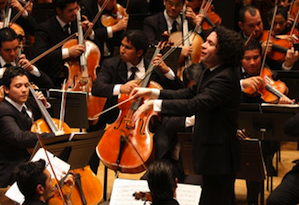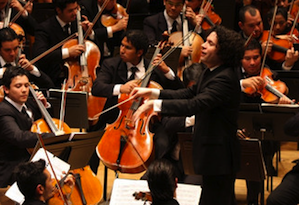
Gustavo Dudamel and the Simón Bolivar Symphony Orchestra of Venezuela returned to the Bay Area this week, generating the kind of goodwill for music education and excitement for symphonic music that can turn even the most hardened cynic into a true believer. A visiting orchestra hasn’t received this kind of visceral response since – well, since the last time the charismatic Dudamel and his youthful ensemble were here.
Thursday at Zellerbach Hall, the orchestra performed the first of two concerts featuring Latin American masterworks. Presented by Cal Performances as part of a residency that included master classes, school performances and a two-day symposium on music education that drew experts from around the world, the event marked a welcome return for this remarkable organization.
Here’s the thing about music education: It works. In these budget-starved times, it’s easy to forget how well it works, until an orchestra such as the Bolivar comes to town and puts the results of a comprehensive music education program on thrilling display. Dudamel’s reputation precedes him, but nothing quite prepares you for seeing and hearing his accomplished 200-member ensemble in action.
It’s been five years since Dudamel and the orchestra — a product of El Sistema (The System), the Venezuelan state-sponsored music education program founded in 1975 by Dr. José Antonio Abreu — made their Bay Area debut. That concert, in 2007 at Davies Symphony Hall, was nothing short of incendiary: a young, gifted conductor leading one of the most exuberant, dynamic ensembles local audiences had ever seen.
Here’s the thing about music education: It works ... Dudamel’s reputation precedes him, but nothing quite prepares you for seeing and hearing his accomplished 200-member ensemble in action.Since then, Dudamel has become an international star (in addition to the Bolivar orchestra, he is currently in his fourth season as music director of the Los Angeles Philharmonic). He and his Venezuelan musicians are older, more musically mature. His podium presence is more economical, and the orchestra has acquired a sleek, cultivated sound. But neither the conductor nor his players have lost their fire.
Thursday’s performance, which launched a U.S. tour that will conclude at Carnegie Hall in December, featured works by Carlos Chávez, Julián Orbón, and Silvestre Revueltas, and the orchestra’s passion, as well as its new level of refinement, were audible from the start of Chávez’s Sinfonia India (Symphony No. 2). To be sure, there was plenty of rhythmic verve in the surging introduction to this 1935 score, which draws on melodies from indigenous Mexican tribes. But what impressed were the details — the serene, silvery woodwinds, the majestic playing Dudamel drew from the sinewy strings. The performance was elegant, unified throughout.
The evening’s centerpiece was a brilliant performance of Orbón’s 1953 Tres Versiones Sinfonicas. Dudamel elicited the subtle sonorities of the Pavane movement with admirable precision and refinement; in the brisk finale, titled Xylophone, the orchestra’s percussion section played with fierce muscularity. Yet the slow, contained energy of the central Organum-Conductus, built on medieval themes, registered with the greatest impact. Under Dudamel’s direction, the movement’s long, shapely melodies shimmered and soared.
After intermission, it was on to Revueltas’ La Noche de los Mayas. The four-movement suite drawn from the composer’s 1939 film score yields unearthly cries from the massed orchestra, lithe cross-rhythms for violins and woodwinds, and pointed outbursts for brass and percussion. Dudamel set and maintained propulsive tempos, and the players responded with tremendous verve; the agile, dancing rhythms of the second movement scherzo sounded particularly lithe and free, and the violins’ honeyed tone and eloquent phrasing were a marvel in the third movement Noche de Yucatan. The percussion section — no fewer than 12 players — brought an electrifying mix of discipline and abandon to their assignment.
The orchestra returned for two encores. First came a vibrant, big-hearted performance of Conga del Fuego Nuevo by Arturo Márquez. Mambo from Bernstein’s West Side Story was saved for last. With the addition of choreography — players leaping from their seats, turning in place and spinning their instruments — this has become one of the Bolivar orchestra’s calling cards, and Dudamel delivered it with raucous drive and enthusiasm.

